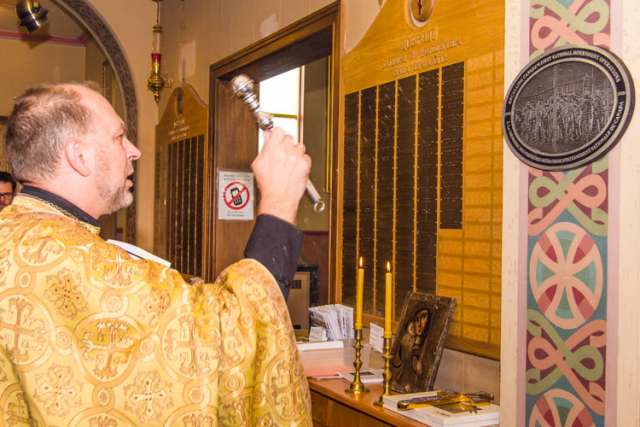“It is really about obviously recalling a historical episode in Canadian history that many people don't know much about,” said Lubomyr Luciuk, Project CTO (Ukrainian for 100) leader. “But by starting this wave of plaque unveiling ... (we're) underscoring that during times of domestic and international crisis Canadians have to remain vigilant about protecting fundamental human rights and civil liberties. It is a message for all Canadians.”
The project, which is the work of hundreds of volunteers from across the country and the Ukrainian Canadian Civil Liberties Association, is the second national commemorative initiative Luciuk, a professor at the Royal Military College of Canada, has led. Back in 1994 Luciuk, along with a number of volunteers, began erecting signs at the sights of the 24 internment camps which were used from 1914 to 1920 — two years after the war ended. These sites — where people from homelands of the nations Canada was at war against — included locations like Fort Henry in Kingston, Ont., Banff National Park in Alberta and The Citadel (also known as Citadel Hill) in Halifax, N.S.
Of the 100 plaques, 36 are located inside Catholic churches. They include St. Michael's Ukrainian Catholic Church in Montreal, the first Catholic site of the unveiling, St. Josaphat's Ukrainian Catholic Cathedral in Toronto, Vancouver's Immaculate Heart of Mary Croatian Roman Catholic Church and St. John the Baptist Ukrainian Catholic Shrine in Ottawa. Plaques have also been installed in Mount Mary Immaculate Retreat Centre in Ancaster, Ont. as well as in a dozen Orthodox
Project CTO on the other hand placed plaques in a variety of culturally significant locations — churches, cultural centres and museum — to the Ukrainian, Croatian, Serbian, German and Hungarian communities. These were unveiled on Aug. 22 at 11 a.m. local time starting in Amherst, N.S., and ending in Nanaimo, B.C.
Funding for this comes primarily from the Canadian First World War Internment Recognition Fund, a $10-million endowment program for commemorative initiatives begun in 2008.
The intention is to get people to talk about and remember a piece of history which Luciuk, a Ukrainian-Canadian educated here, said he never heard about growing up until working on his MA at Queen's University in his hometown Kingston, where the first Canadian internment camp was established in 1914 at Fort Henry.
“I lived here all my life, I played on Fort Henry hill after Mass on Sundays,” he said. “I never heard anything about that, never knew a word about that and never heard from any professor or teacher what had happened, so this just hit me like a ton of bricks,” when he discovered this during a thesis research interview.
After Fort Henry an additional 23 internment camps were built under the War Measures Act as Canada began rounding up those connected to the Central Powers, many of whom left their homeland to avoid participating in the war or were born in Canada. Those who were not interned, some 80,000, had to register and regularly report to local authorities, effectively publicizing them as “enemy aliens.”
The War Measures Act has been invoked two more times in Canada, with Japanese-Canadians being interned during the the Second World War and again in 1970 during the October Crisis in Quebec.
Although history books widely acknowledge the two more recent internment instances, very little attention has been given to the First World War camps. Luciuk said the formal records and internment camps themselves were quickly destroyed following the closure of the final camp, Bunk Houses in Kapuskasing, Ont., on Feb. 24, 1920. Before this closure more than 100 people died while serving in the labour camps. It is likely many more would die as a result of being forced to work hard labour, earning only $0.20 an hour, after internees began being paroled in 1916 to address a labour shortage.
“Much of the infrastructure of Banff National Park was built by internee labourers,” he said. “Same thing with Jasper. So the jewels on the crown of Canadian national park system was in part built by internees.”
Another example he pointed to Toronto's Stanley Barracks located on the same grounds as the Canadian National Exhibition.
“The rides and the carnival part of all of that was an internment came for enemies in World War I.” he said. “We go to many cities that you or I are familiar with, whether it is Winnipeg or Montreal or Toronto ... these places all had internment camps. You and I never heard about this in school, there really wasn't that much.”
That being said Luciuk continued by saying that part of the endowment fund from the government is being used to support the development of education material on this topics for Canadian schools.
Chair of Ukrainian Studies at the University of Toronto Fr. Anthanasius McVay also said remembering this rarely heard of event from the turn of the century is important.
“These commemorations should be about remembering history as a memory of mankind,” he said in an interview with Vatican Radio. “We owe it to history to remember these events and to make some symbolic redress.”
McVay places the blame more on the population of that era for being “very suspicious and fearful,” than the government although he did say the government “exceeded their mandate,” to ensure local activity would not be detrimental to the war effort.
That being said McVay and Luciuk noted that this should not be seen as an attempt to raise bitterness and resent but rather to avoid repeating the mistakes of the past.
“The campaign should be about memory not money,” Luciuk. “I'm sure you can think of a dozen other communities that are constantly saying we are injured, we suffered, we were discriminated against ... pay us, compensate us, forever. If people had remembered what they had did ... during the First World War under the War Measures Act perhaps it wouldn't have happened (again).


